The changing face of orthodontics Understand article
Many of us have had our teeth straightened with braces. Few people know, however, that orthodontics involves a great deal of fundamental science and fast-moving technology.
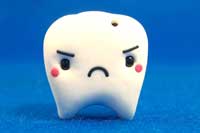
Tony Bot; image source: Flickr
Most of us are familiar with orthodontics as a kind of mechanical engineering inside the mouth – all those metal braces, plates and wires. But how many of us are aware of the different sciences involved in this area of dentistry? Today’s orthodontists have to understand and apply a good deal of specialist science – everything from genetics to metallurgy.
What is orthodontics?
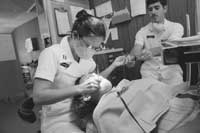
Archives and Records
Administration; image source:
Wikimedia Commons
Orthodontics is the branch of dentistry concerned with diagnosing and correcting irregularities of the teeth and jaws. It is used for far more than achieving a perfect Hollywood smile: our jaws and teeth are used for talking as well as chewing, so orthodontics is concerned with how facial anatomy affects these functions, as well as with cosmetic improvements.
As orthodontists, we are always seeking the latest insights and techniques from relevant scientific fields and applying them to our work. Some examples are in table 1. In this article, we will look at several of these areas in more detail.
| Genetics | We need to be able to diagnose whether a problem has a genetic cause, so we can treat it effectively. |
| Growth and development | Faces change as they mature and age, due to alterations in body tissues. Understanding these processes allows us to positively influence them. |
| Physiology | Everyone is different in precisely how they breathe, chew, swallow and speak. Function and form are closely related, so these processes form part of each patient’s diagnosis and treatment plan (figure 1). |
| Microbiology | By teaching our patients about oral health and plaque removal, we help prevent tooth decay and gum disease. |
| Biomechanics | We apply the laws of mechanics to adjust the position of teeth. We need to ensure that the forces resulting from our work produce only the movements that are needed. |
| Metallurgy and materials science | As well as metals, we use alginates and silicones for taking impressions, composites and glass ionomer cements for sealing and sticking, plaster for making casts, and resins for creating removable appliances. We need to understand each material’s physical and chemical properties to use them in the best way for each patient. |
| Physics | Many orthodontic resins can be cured (polymerised) using light. Four main types of polymerising light source are available: halogen bulbs, plasma arc lamps, argon ion lasers, and light-emitting diodes. |
| Radiology | Radiographs help us to diagnosis complex problems. We use many different types of radiographs, to provide views from different angles (frontal, profile or panoramic) or exploit different imaging techniques (scanners, magnetic resonance imaging and cone beam computed tomography). |
Genetics and molecular biology in orthodontics
Some of the problems that orthodontists deal with are genetic in origin (figure 2). Although most of these are minor, others result from genetic abnormalities in the way that the head and face develop before birthw1. In the embryo, the development of facial structures begins with neural crest cells forming at the site of the brain. These cells then migrate to form a tissue that differentiates into cells called osteoblasts, chondroblasts and odontogenetic cells. These then develop to form the hard tissues of the head and neck – the bones, cartilage and teeth.

Image courtesy of Sophie and Georges Rozencweig
During this process, molecules called signalling factors and transcription factors play an important part. Signalling factors are a cell’s way of triggering a response in another cell, while transcription factors control which specific DNA sequences are used to produce mRNA and thus proteins. For example, we now know that if the signalling factor TGF-β is inactive, this causes cleft palatesw2 and upper jawbone malformations. Mutations in the receptor sites (where the response is triggered) for the signalling factor FGF also cause a large number of craniofacial abnormalities.

Image courtesy of Sophie and Georges Rozencweig
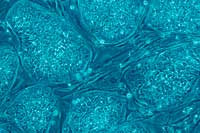
Researchers are investigating
whether stem cells can be
encouraged to grow into
teeth.
Image courtesy of Nissim
Benvenisty; image source:
Wikimedia Commons
Another example is the transcription factors associated with the homeobox genes. These transcription factors are especially important in enabling the neural crest cells to develop into the skeletal structures of the head and face, so defects in the way these genes are transcribed can lead to abnormalities in facial development.
Another example of the importance of molecular biology to orthodontics is the recent discovery that dental pulp (the area of connective tissue at the centre of a tooth) contains valuable adult stem cells, which can be induced to form other types of cells. Thus when a tooth is extracted or falls out, the stem cells may be harvested and stored for future treatment. Stem cells are already being used to treat some cancers, and additional applications may be on the horizon. For example, researchers are exploring whether stem cells can be used to grow a natural replacement for a missing tooth.
Biomechanics and orthodontics
The amount of force needed to move a tooth depends on its size and the type of movement (turning or sliding). The moving force also needs an anchor, so a group of teeth and appliances are selected and used as anchorage (figures 3 and 4).

Left: An X-ray taken after the extraction, showing the hole where the upper left canine was removed, and the mini-plate that was used to close the gap.
Right: The result: the first upper left premolar has been moved forward to replace the missing canine.
Images courtesy of Sophie and Georges Rozencweig

Middle: Early in the treatment, showing the gap left by the removal of the tooth.
Right: The gap has been successfully closed.
Click on image to enlarge.
Images courtesy of Sophie and Georges Rozencweig
As orthodontists, our task is to decide on the best combination of forces and anchorage to achieve the right movements, without any adverse effects. We review each stage of treatment to make sure this is happening; if it is not, we need to change the treatment plan.
In traditional orthodontics, appliances such as headgear and intra-oral elastics are used to reinforce anchorage, which require a good deal of patient co-operation. Today, titanium mini-screws can be used instead in some cases (figure 4).
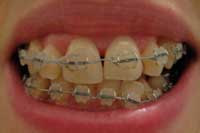
what connect the braces,
acting like an engine to guide
and move the teeth. Without
the wire, the teeth would never
move.
Image courtesy of bluebike;
image source: Flickr
Metallurgy and orthodontics
The forces used in orthodontics come from the archwires (figure 5). At the beginning of the treatment, the wires need to be quite elastic to start individual teeth moving. Later on, the wires have to be more rigid to ensure stability while a whole block of teeth is moved.
Orthodontists can choose wires made from a variety of metallic materials:
- Stainless steel: this is easy to shape and has high rigidity so it provides stability.
- Nitinol alloys: these nickel-titanium alloys have very high elasticity. They produce a weak but constant force suitable for the initial alignment phases. However, they cannot be soldered.
- Shape-memory alloysw3: these metals have variable elasticity depending on the temperature. They can be bent for insertion into the mouth; once there, they ‘try’ to recover their initial shape, exerting a force on the teeth.
A dynamic discipline
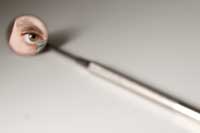
be complete without having
every crevice of your mouth
explored with a small
circular mirror.
Image courtesy of ben
matthews :::; image source:
Flickr
As you can see, orthodontists need to be good all-round scientists to keep up with the changing knowledge and technological innovations in their discipline. So, if a student in your class misses a science lesson because of an appointment with an orthodontist, don’t worry – it might be the perfect opportunity to learn about the latest findings in molecular biology, or provide inspiration to a budding materials scientist.
Web References
- w1 – See a BBC video clip about facial development in the womb.
- w2 – This animation shows how a cleft palate develops (voiceover in Russian).
- w3 – The website of the UK’s National STEM Centre offers a free downloadable booklet about metals and shape-memory alloys, together with suggestions for teachers on how to introduce the ideas in the classroom, plus student activity sheets and notes for teachers and technicians.
Resources
- The Archwired website, maintained by an adult wearer of orthodontic braces, hosts articles on various orthodontic topics.
- For example, how braces work or a brief history of orthodontics.
- Another short history of orthodontics on the About.com website
- The Braces Knowledge Base website, also maintained by a braces wearer, offers comprehensive illustrated information about orthodontic devices.
- The website of the British Orthodontic Society offers information about education and research as well as careers in orthodontics.
- Dentistry has a surprisingly long history. Recently, a filling was found in the fossilised jawbone of a man who lived 6500 years ago in what is now Slovenia. To learn more, see:
- Bernardini F et al. (2012) Beeswax as dental filling on a Neolithic human tooth. PLOS One 7(9): e44904. doi: 10.1371/journal.pone.0044904
- PLOS One is an open-access research journal, so this and all other articles in it are freely available.
- Barras C (2012) Oldest dental filling is found in a Stone Age tooth. New Scientist.
- To learn more about how light can be used in polymerisation, see:
- Douglas P, Garley M (2010) Chemistry and light. Science in School14: 63-68.
- To find out more about how stem cells can be used in medicine, see:
- Hadjimarcou M (2009) Review of Potent Biology: Stem Cells, Cloning, and Regeneration. Science in School 11: 92.
- Funded by the European Commission, the Eurostemcell website offers information and educational resources on stem cells and their impact on society.
Review
Everybody has an experience of visiting the dentist: for some, these visits involve nothing more than a quick poke around and a polish; for others, it can be a very traumatic experience.
However, to what extent do we understand the role of a dentist? In the UK, all dentists must undergo a 5-year period of study to gain a primary dental qualification. Those who wish to specialise in orthodontics will need both dentistry experience and a further 3-year specialist qualification. In addition to clinical training and practice, the dental student will learn about molecular biology, anatomy and physiology, materials science and human disease. As a dental student with whom I was at university put it, “It’s all connected, you know!”
Dentistry is a career many young people choose to study at university. However, certainly in UK schools, very little (if any) time is spent studying the mouth, teeth or dental science. This article provides excellent reading material for those students who are thinking of a career in dentistry. It could be used by teachers to provide an introduction to dentistry and its subspecialties, and to help students make an informed choice about their prospective careers.
In addition, the article provides an alternative context for biology lessons on transcription and translation of DNA, cell signalling and cell differentiation, and totipotent stem cells. Teachers may wish to use the article as a basis for a group discussion or research project; alternatively they may wish to recommend it as background reading material before the commencement of teaching. For physics and materials science lessons, the article also provides an insight into real-life applications of alloys, composites and smart materials. In a social context, the article can serve as a basis to discuss health care in the developing world, using the treatment of cleft palates as an example.
Jonathan Schofield, McAuley Roman Catholic High School, Doncaster, UK





